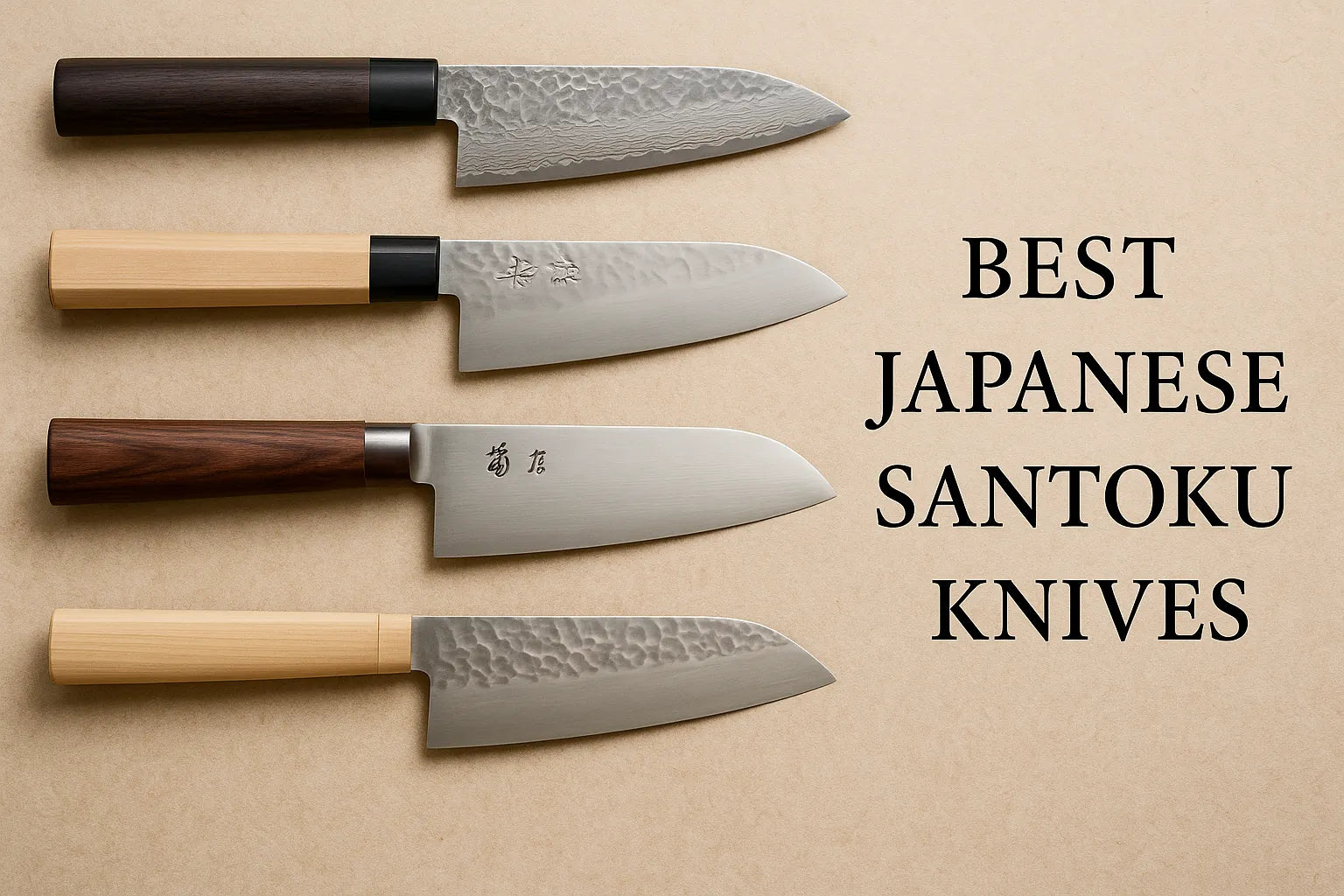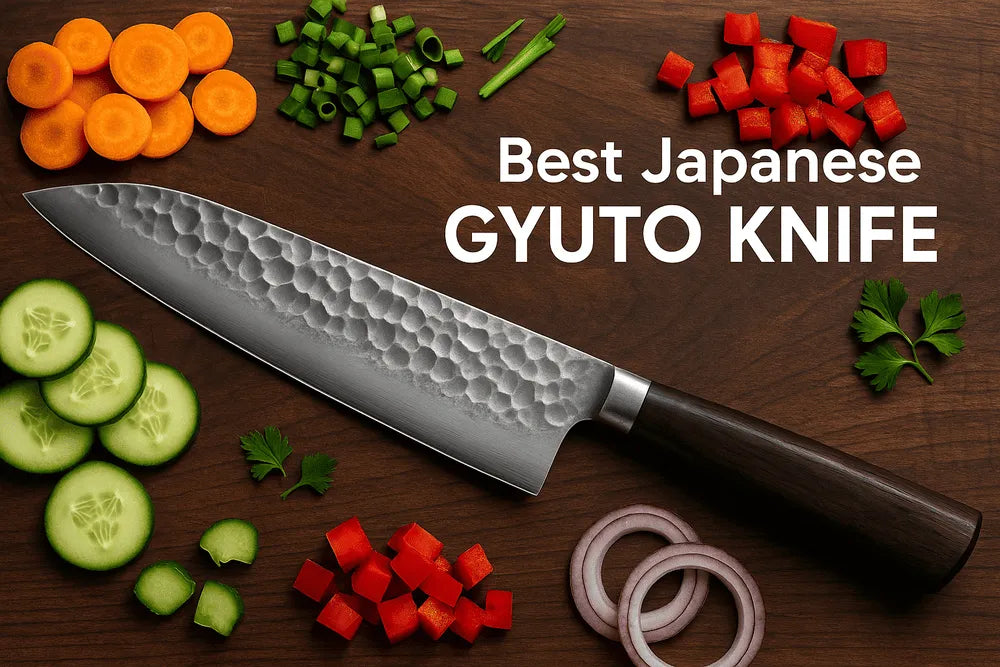Which is better: Damascus knife vs stainless steel? A Damascus knife stands out for its layered beauty and fine slicing feel, while a stainless steel knife wins for easy care and durability. Each material performs differently; one shows artistry, the other practicality.
If you want to find out which blade fits your cooking habits best, keep reading to see how they compare in look, sharpness, and maintenance.
1. Quick Comparison Table: Damascus Knife vs Stainless Steel Knife
When choosing between a Damascus knife and a stainless steel knife, the differences mainly come from craftsmanship, maintenance, and price.
The table below highlights the main features so you can easily see which suits your cooking habits and kitchen setup.
|
Feature |
Damascus Knife |
Stainless Steel Knife |
|
Corrosion Resistance |
Moderate, can rust if not dried and oiled properly |
High, resists rust, moisture, and staining |
|
Edge Retention |
Excellent, holds a sharp edge for long periods |
Good, reliable sharpness, may dull faster |
|
Sharpness Feel |
Razor-sharp with fine slicing precision |
Smooth, durable, and consistent for daily use |
|
Toughness |
Harder, but can chip if used roughly |
More forgiving, less likely to chip or crack |
|
Ease of Sharpening |
Requires skill and whetstone sharpening |
Easier to maintain with basic tools |
|
Maintenance |
Needs careful cleaning, drying, and occasional oiling |
Simple care — rinse, dry, and store |
|
Visual Appeal |
Decorative layered patterns, handcrafted artistry |
Clean, polished, and modern appearance |
2. What is Damascus Steel?
Damascus steel is known for its ancient, high-carbon crucible steel. The name originates from ancient Damascus, a center renowned for its expertise in weapons and blade production. Modern Damascus steel differs from the original “wootz” steel, which was once made in India and the Middle East. Today, makers use pattern-welding, a process that forges multiple layers of high- and low-carbon steels together.
The steel is heated, folded, and hammered many times to form a strong, flexible core with striking patterns on the surface. After polishing and acid etching, the alternating layers become visible, giving Damascus blades their signature texture and depth.

Typical characteristics:
- Layered construction (often 50–200 layers).
- A combination of toughness, edge retention, and flexibility.
- Made from steels like 1095, 15N20, VG-10, or AUS-10 for balanced hardness.
- Each blade has a distinct pattern - no two look the same.
Modern Damascus steel patterns are not just decorative; they reflect skilled craftsmanship and the blending of metals.
3. What is Stainless Steel?
A stainless steel knife is made from an alloy of iron mixed with at least 10.5% chromium, which protects the blade from rust and staining. The chromium reacts with oxygen to form a thin oxide layer that prevents corrosion. Stainless steel is the most common choice for kitchen knives because it balances durability, sharpness, and easy care.

Knife makers use several stainless steel types depending on performance needs:
- VG-10: Premium Japanese steel with high carbon and vanadium for hardness and fine edges.
- AUS-8 / AUS-10: Good corrosion resistance with moderate hardness, easy to sharpen.
- SG2 / R2 powder steel: High-end stainless with excellent hardness (around 62 HRC) for long-lasting edges.
Key properties of stainless steel knives:
- Rust- and stain-resistant for daily kitchen use.
- Easy to clean and maintain with mild soap and water.
- Tough enough for heavy chopping and repeated washing.
- Sharper lifespan varies by grade - higher-end steels hold edges longer.
In short, stainless steel knives trade a bit of sharpness for convenience and longevity. This sets the stage for comparing them directly with Damascus knives, which focus more on craftsmanship and layered performance.
If you are wondering carbon steel vs stainless steel knife, let's find out more: Carbon Steel vs Stainless Steel Knife: Which Should You Buy?
5. Performance in the Kitchen
When it comes to performance in cooking, both Damascus knives and stainless steel knives perform well, but they feel different in your hand and behave differently on the cutting board. The choice depends on how you cook, what ingredients you use, and how much time you spend maintaining your tools.

5.1. Cutting Performance
A knife’s main purpose is to cut cleanly and efficiently. The way the blade glides through ingredients shows how well the material holds an edge and transfers power from your hand to the board. Both steels perform well, but they deliver a different cutting experience.
Damascus Knife
- The layered steel construction gives excellent cutting precision.
- The harder core maintains a sharp edge longer, ideal for thin slices of meat, fish, or vegetables.
- Cuts feel smoother due to the fine grain and mirror polish on the blade.
- The pattern also helps reduce food sticking to the surface during slicing.
Stainless Steel Knife
- Performs consistently across most tasks, from chopping onions to trimming poultry.
- Slightly softer steel means the edge may dull faster, but it is easier to resharpen.
- Works well for heavy-duty tasks like cutting root vegetables or thick-skinned fruits.
- More forgiving if the knife twists or hits hard surfaces.
Expert tip: Professional chefs often pair both types - a Damascus knife for delicate prep and a stainless steel knife for everyday chopping and rough work.

5.2. Balance and Handling
The way a knife feels in your hand affects accuracy and comfort. Good balance helps control each slice and reduces strain during long cooking sessions. Damascus and stainless steel knives are both well-designed but have different weights and center points.
Damascus Knife
- Usually features a well-balanced design with a weight-forward feel for precise control.
- The balance point near the bolster helps steady movements when slicing thin or decorative cuts.
- Many Damascus knives have a slightly heavier blade, giving a stable, confident grip during fine work.
Stainless Steel Knife
- Often lighter and evenly balanced from handle to tip.
- Comfortable for long use, especially in high-volume kitchens.
- The reduced weight makes it easier for beginners to handle without wrist strain.
Expert tip: If you prefer detailed, artistic work, choose Damascus for its weight and precision. For long prep hours or quick-paced cooking, stainless steel offers comfort and agility.

5.3. Comfort and User Experience
Comfort determines how often you reach for a knife. The right handle, grip, and weight distribution can make prep work faster and less tiring. Damascus and stainless steel knives differ slightly in feel, depending on your technique and preferences.
Damascus Knife
- Feels smooth and refined in hand; the layered surface provides slight friction for control.
- Works best with proper cutting technique, ideal for users who already know how to maintain angle consistency.
Stainless Steel Knife
- Simple, predictable, and easy to handle for all skill levels.
- Rounded spines and ergonomic handles reduce fatigue during daily use.

6. How to Choose: Damascus Knife vs Stainless Steel
Choosing between a Damascus knife and a stainless steel knife depends on your cooking habits, maintenance routine, and what you value most in a blade: artistry or practicality. Both materials perform well, but each offers a different kitchen experience. The guide below helps you decide which fits your needs best.
|
User Type / Preference |
Damascus Knife |
Stainless Steel Knife |
|
Professional Chefs |
- Offers unmatched sharpness and visual beauty. - Ideal for precise slicing, sushi, and presentation work. |
- Reliable for long shifts and repetitive prep. - Great balance of sharpness and toughness. |
|
Home Cooks |
- Best for those who enjoy knife care and sharpening. - Adds a premium look to your kitchen tools. |
- Simple maintenance; easy to clean and store. - Perfect for quick daily meals. |
|
Edge Retention Priority |
- Excellent; keeps a razor edge for long sessions. |
- Good; retains edge well under regular use. |
|
Corrosion Resistance Priority |
- Moderate; needs hand washing and drying after use. |
- High; chromium layer prevents rust and staining. |
|
Budget & Skill Level |
- Higher cost; better for enthusiasts or experienced users. |
- Affordable and beginner-friendly for everyday use. |
Quick Tips for Choosing
- Want a knife that combines craftsmanship and sharpness? => Choose a Damascus knife.
- Prefer easy maintenance and all-around practicality? => Go with stainless steel.
- Enjoy collecting or using handmade tools? => Damascus is worth the investment.
Expert tip:
If you treat your knives with care and love craftsmanship, a Damascus knife rewards you with beauty and edge performance. If you value simplicity and convenience, stainless steel offers all-around reliability.
Final Words
Both Damascus and stainless steel knives have earned their place in modern kitchens. Damascus offers elegance, superior edge feel, and craftsmanship that attracts chefs and collectors alike. Stainless steel delivers consistent performance, corrosion resistance, and peace of mind for everyday cooks. The right choice depends on how you cook, how much time you spend maintaining your tools, and what kind of knife experience you enjoy.
FAQs
-
Yes. Traditional Damascus knives made with high-carbon steel can rust if not dried and oiled after use. The wavy surface does not prevent corrosion — it only shows the layers of steel.
To prevent rust, wash the knife by hand, dry it completely, and apply a thin coat of food-safe oil. Some modern Damascus blades use stainless layers that reduce rust risk but still need care. -
Usually, yes. Damascus steel often has a harder core that keeps a fine edge longer. However, it requires regular honing and careful handling to maintain that sharpness.
High-end stainless steels such as VG-10 or SG2 can match or even outperform some Damascus knives in edge life, depending on usage and maintenance. -
Both can last decades with care. Damascus knives may outlast stainless steel if properly maintained, as their layered design supports excellent edge strength.
Stainless steel knives last just as long for daily use and require less attention, making them practical for most kitchens.



